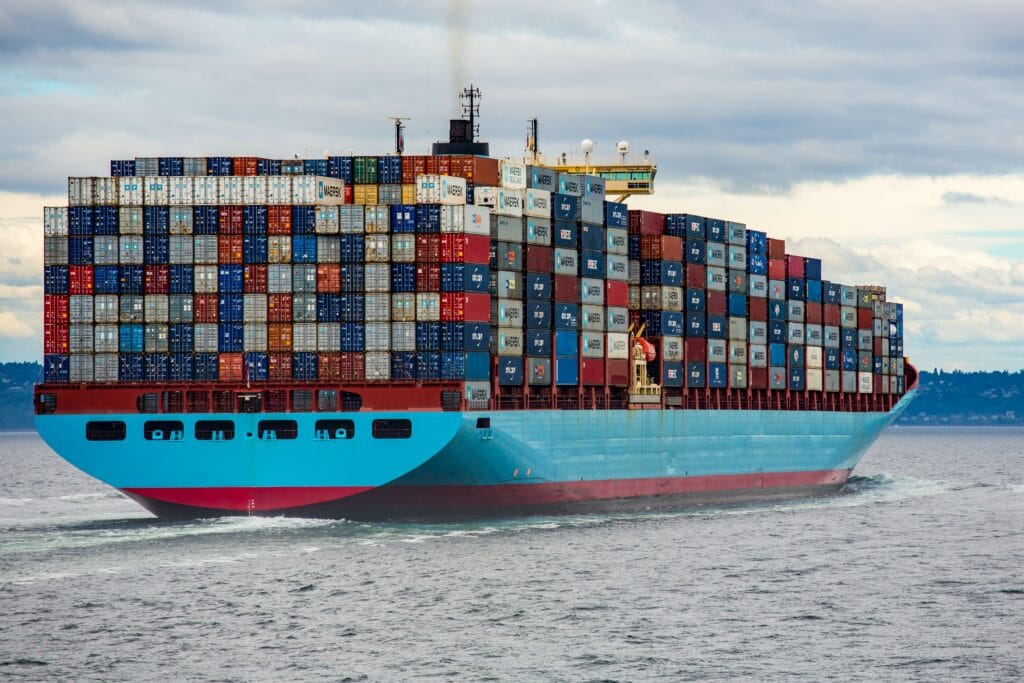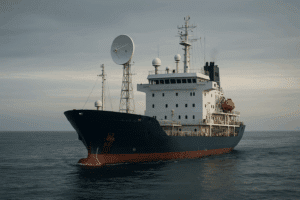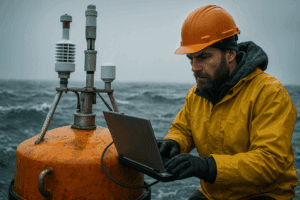As global trade, the population, and demand continue to grow, port congestion (the wait time of a ship at anchorage to dock at berth) only worsens.
The main cause of port congestion is a lack of digitization in the maritime industry. This lack of digitization then causes a myriad of other problems for the entire supply chain.
What Is Port Congestion?
Port congestion happens when there are too many cargo ships that need to dock at berth to unload/load than a port can handle. In port terminals, carriers can arrive with 10,000 – 20,000 containers (TEUs) in one freight shipment. Container ships then must wait outside the port at anchorage until a berth is available. Many container ships wait a long time, even up to two weeks, to dock at berth.
As ports are a primary international supply chain node, port congestion affects the entire value chain. For example, consumers face shipping delays for weeks which affect their business, while shipping companies pay demurrage, freight rates, and extra operational costs for the long delays.
As the liner industry moves 4 trillion dollars of goods annually, all processed through ports, logistics issues like port congestion and long waiting times must be given more attention, visibility, and transparency.
How to Track a Ship In Real-Time ?
Let us look at how a ships’ real-time tracker works, its details and features, its benefits for all players in the shipping sector but also its weaknesses…
What Are the Major Causes of Seaport Terminal Congestion?
What it comes down to is one main cause – a lack of digitization in the maritime sector. Lack of digitization stems from underinvestment in the maritime sector in the last 15 years while global demand for goods has continued to increase, and it is at the root of what causes port congestion. That is why there is such a push for the maritime industry to adopt digital strategies such as Smart Ports and Digital Twins.
Following are the main problems due to lack of digitization that cause port congestion:
Port Infrastructure Cannot Deal with Capacity
Port infrastructure is unable to deal with the increasing number of containers they are receiving. There is a lack of available space, lack of resources, lack of crew, and lack of equipment. As many countries receive more imports than they are exporting, empty containers are sitting on quays as ports are being inundated with new cargo. If this cargo cannot be moved to shore quickly, then everything is backed up. There are not enough trucks, chassis (a chassis is what trucks use to tow the containers), or railways to move the cargo quick enough.
Moreover, for the first time ever, the maritime business is witnessing mega container ships. Mega container ships, like the famous Ever Given, carry over 20,000 TEUs. These vessels are also leading to increased port congestion – and even events such as a high-risk situation like what happened in the Suez Canal in Spring 2021. – It takes much longer to unload a 20,000 TEU ship than the past 8,000 TEU carriers. Carriers are therefore docked and berthed for much longer.
How Digital Technology Helps
If the maritime sector were more digitalized, then increasing ship capacity could be better handled. For instance, Smart Ports are now increasingly common. Smart Ports use digital technologies to enhance their use of infrastructure to accommodate the growing industry. Digital technologies contribute to greater efficiency by using Artificial Intelligence, Big Data, blockchain, IoT, and automation to predict events, increase safety, and accommodate newer and larger vessels with the use of on-site automation. For example, Smart Ports use automated cranes and trucks to process cargo quicker, allowing more cargo to be processed without the need for more on-site workers. With Sinay, a Smart Port strategy can be easily developed to increase operational efficiency for all maritime activities.
Pandemic Led to Increased Consumer Spending
During the COVID19 pandemic, everyone had to stay home. Many people realized they needed more materials to be more comfortable… always being at home. According to South Carolina Port Authority CEO, this led to a buying surge that the world had never seen before. As consumers ordered more products globally, ports became more congested. Their infrastructure was not prepared for this.
However, already before the pandemic, ports were congested due to growing world demand and a lack of digitalization. In maritime logistics, there is not a lot of transparency and port infrastructures are old. Therefore, this surge pushed many ports and shipping companies over the edge, as the average shipping rate is now four times the number of pre-pandemic conditions.
Companies like Peloton, an exercise equipment and media company, estimated they will spend 100 million dollars in transportation fees such as air freight to get around current international demand bottlenecks. The State of Georgia built a truck-only highway to deal with increasing truck traffic coming from ports, and companies like Gap, Urban Outfitters, and Foot Locker have posted publicly on their websites that there will be long delays to receive orders. Evidently, this congestion is causing problems for end-to-end consumption.
How Digital Technology Helps
If ports and shippers could track barges and had a precise estimated time of arrival (ETA) for vessels, then the increasing amount of consumer spending and shipping would be better handled. With Sinay’s ETA Module that uses Artificial Intelligence algorithms to continually updates a ship’s estimated time of arrival with included ship tracking, ports can better schedule crews, resources, and the berthing of vessels to be as efficient as possible. With a precise real-time ETA, shippers can also choose which port is best for them regarding current traffic conditions.
With a more efficient port, comes a more efficient and transparent supply chain.
How to Track a Ship In Real-Time ?
Let us look at how a ships’ real-time tracker works, its details and features, its benefits for all players in the shipping sector but also its weaknesses…
Unforeseen Events
Unforeseen events, like the Suez Canal blocked by the massive Ever Given liner, are putting immense pressure on logistics. Many barges are not equipped with the right technologies, and therefore it is more likely that high-risk events like this happen. On top of that, maritime infrastructure is equally not prepared for the fast-growing shipping increase.
Due to weather events, some cargo shipments lose a massive amount of freight. In fact, more than 3,000 TEUs fall into the ocean every year.
How Digital Technology Helps
If the maritime sector had more visibility and digitization for shipping, then unforeseen events would not be so catastrophic. At Sinay, for instance, we offer Risk Management Modules that help shipping companies track vessels and locate dangerous areas due to weather events or political circumstances.
Also, with our logistics modules, ships can be tracked in real-time which allows shippers to warn captains of predicted weather forecasts. Digitalization allows real-time communication and the possibility to predict and avoid dangerous events.

Intense Congestion Due to Lack of Digitalization in the Maritime Sector
If one main port goes down, is backed up and already at full capacity, or is not efficient, then the sum of all parts is equally affected. They are the key node in logistics, and if something goes wrong with them, then quality and reliability goes down across the board. This problem therefore impacts not only ports, but also shippers, consumers, the surrounding community, the environment, retailers, and hinterlands.
Port digitalization thus has a positive impact on the maritime sector, for if a port is more efficient then so is the rest of the supply chain. The best way to increase efficiency and decrease delays is to adopt digital strategies. Ports that do this will gain a competitive advantage – many ports internationally are already adopting digital Smart Port strategies.
Real-World Consequences of Undigitized Port Operations – Port of Los Angeles in California
Since the pandemic, American consumers are buying goods not services. Thus, the supply chain is seeing 50 percent more activity in the first six months of 2021 than in 2020. As American imports rise exports decline, thus Los Angeles is shipping back two times the number of empty containers. Containers are now dwelling twice as long on quays, an average of 30 container vessels at a time are sitting off the coast (normally it is 0-1), extra barges are arriving (when there is more cargo there is less efficient movement of goods on shore), and ships wait an average of 7.5 days to dock at berth. Los Angeles is now dealing with 31 percent more ships and 49 percent more containers than before.
According to Gene Seroka, Port of Los Angeles Executive Director, they need nationwide adoption of digitization to deal with the increased activity. Digitization gives shippers more transparency and will allow over 60,000 trucks and 100 trains to work efficiently. Information must be shared more fluently, and one of the best ways to do that is through digital technologies.
Key Takeaway
If maritime activities, ports, and the shipping industry were digitized, port congestion would reduce and efficiency would increase, as there would be increased visibility and transparency between all stakeholders.
Sinay helps ports and shipping companies adopt digital strategies and software to help increase their efficiency. With our Sinay Hub, we offer a 360-degree view of all environmental and logistic maritime activities. We also offer a one-on-one Smart Port workshop for those who want help processing their data to choose the best Smart Port strategy for their business activities. As digital technologies are the way of the future, we are here to help with your Smart Port transition.
Frequently Asked Questions About: PORT CONGESTION
Port congestion is when there are more ships that need to dock at a port than the port can handle. The effects of this are severe global supply chain blockages. This is currently affecting countries worldwide.
Port congestion happens when there are too many cargo ships that need to dock at berth to unload/load than a port can handle. Ships can then wait at anchorage (outside the port) for up to two weeks.
Port congestion can best be prevented by adopting digital port solutions. Digitalization provides transparency among all supply chain actors.
West Coast ports are congested due to intense increasing consumer demand, and port infrastructure cannot deal with the increased capacity. There is also a lack of digitalization in the maritime sector which contributes to West Coast port congestion.


